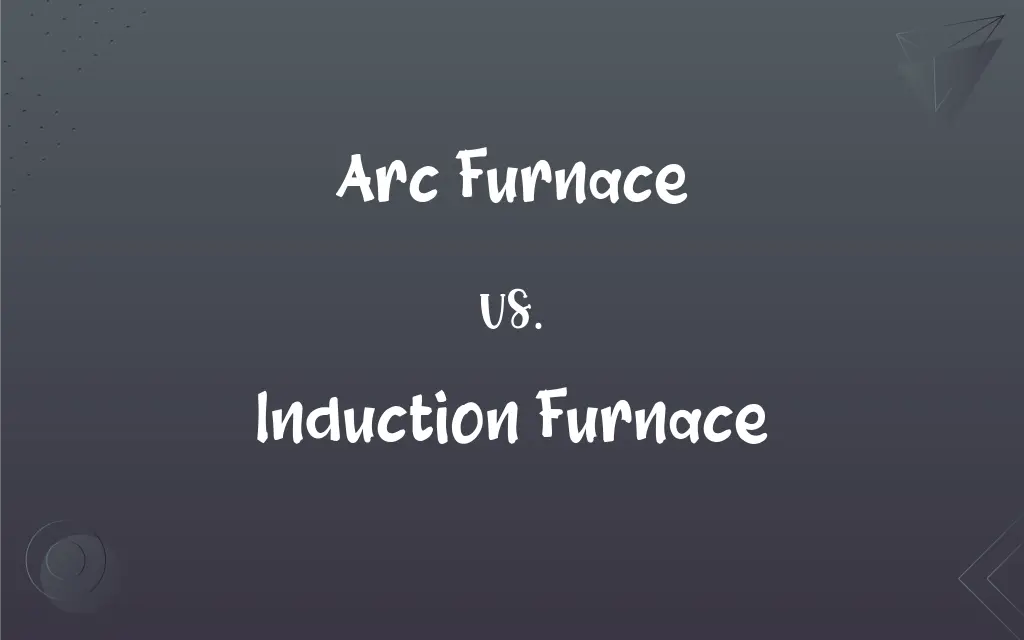Arc Furnace vs. Induction Furnace: What's the Difference?
Edited by Aimie Carlson || By Harlon Moss || Published on February 11, 2024
Arc furnaces use electric arcs to melt materials, while induction furnaces use electromagnetic induction for melting.

Key Differences
An arc furnace melts materials using an electric arc generated between electrodes, suitable for large-scale steel production. Induction furnaces, conversely, melt materials using electromagnetic induction, a process ideal for precise control over the melting process.
Arc furnaces are known for their capacity to handle large batches, making them common in heavy industry. Induction furnaces are smaller and more efficient, preferred in industries requiring meticulous alloy compositions.
In terms of energy consumption, arc furnaces require a high amount of electrical energy to generate the necessary heat. Induction furnaces are more energy-efficient, using electromagnetic fields to heat materials directly.
The operational speed of an arc furnace is relatively faster due to the intense heat from the electric arc. Induction furnaces, while slower, offer a higher degree of temperature control and uniformity.
Environmentally, arc furnaces produce more emissions and noise, posing greater environmental and occupational challenges. Induction furnaces are cleaner and quieter, aligning better with environmental regulations.
ADVERTISEMENT
Comparison Chart
Heating Mechanism
Electric arc between electrodes
Electromagnetic induction
Batch Size
Larger, suited for heavy industry
Smaller, precise control for specific alloys
Energy Efficiency
High energy consumption
More energy-efficient
Operational Speed
Faster melting due to intense heat
Slower with better temperature control
Environmental Impact
Higher emissions and noise
Lower emissions, quieter operation
ADVERTISEMENT
Arc Furnace and Induction Furnace Definitions
Arc Furnace
A device for melting large quantities of metal.
The company invested in an arc furnace to increase production capacity.
Induction Furnace
A furnace that melts metal using electromagnetic induction.
The induction furnace provided precise temperature control for alloy creation.
Arc Furnace
A high-temperature furnace used in steelmaking.
The arc furnace's intense heat is essential for producing high-quality steel.
Induction Furnace
A furnace used for small to medium batch metal melting.
The induction furnace is ideal for the foundry's custom casting projects.
Arc Furnace
A furnace suitable for large-scale metal recycling.
The arc furnace is central to the plant's metal recycling operation.
Induction Furnace
An energy-efficient furnace for metal processing.
To reduce energy costs, the plant switched to an induction furnace.
Arc Furnace
A furnace that melts materials using an electric arc.
The steel mill used an arc furnace for rapid melting of scrap metal.
Induction Furnace
A device for efficient and controlled metal melting.
Their workshop uses an induction furnace for specialized metalworking.
Arc Furnace
An industrial furnace using electrical energy.
Their facility upgraded to a more efficient arc furnace for metal processing.
Induction Furnace
A clean and quiet option for metal melting.
The new induction furnace improved the workshop's working environment.
FAQs
What materials are typically melted in an arc furnace?
Mainly steel and other metals.
Is an arc furnace suitable for small-scale operations?
No, it's better for large-scale industrial use.
What is an arc furnace?
A furnace that uses electric arcs to melt materials.
Can induction furnaces melt different metals?
Yes, they are versatile for various metals, including iron and steel.
What industries use arc furnaces?
Primarily the steelmaking and metal recycling industries.
Where are induction furnaces commonly used?
In foundries and small to medium-sized metalworking shops.
Can induction furnaces control temperature precisely?
Yes, they offer excellent temperature control.
Can arc furnaces recycle scrap metal?
Yes, they are commonly used for recycling large quantities of metal.
What is an induction furnace?
A furnace that melts materials using electromagnetic induction.
Are induction furnaces energy efficient?
Yes, they are more energy-efficient than arc furnaces.
How fast can an arc furnace melt materials?
It can melt large batches rapidly due to the intense heat of the electric arc.
How do arc furnaces affect workplace noise levels?
They significantly increase noise levels in industrial settings.
What is the environmental impact of arc furnaces?
They tend to have higher emissions and noise levels.
Are induction furnaces environmentally friendly?
Relatively, as they produce lower emissions and less noise.
What's the maintenance like for an arc furnace?
They require regular maintenance due to their high operational intensity.
Are induction furnaces suitable for educational purposes?
Yes, due to their safety and control features.
Do arc furnaces require a lot of electrical power?
Yes, they consume a significant amount of electrical energy.
Is specialized training needed to operate an induction furnace?
Basic training is needed, but they are relatively straightforward to operate.
Is it easy to operate an induction furnace?
Yes, with proper training, they are user-friendly.
Can induction furnaces be used for alloy production?
Yes, they are ideal for creating specific alloys.
About Author
Written by
Harlon MossHarlon is a seasoned quality moderator and accomplished content writer for Difference Wiki. An alumnus of the prestigious University of California, he earned his degree in Computer Science. Leveraging his academic background, Harlon brings a meticulous and informed perspective to his work, ensuring content accuracy and excellence.
Edited by
Aimie CarlsonAimie Carlson, holding a master's degree in English literature, is a fervent English language enthusiast. She lends her writing talents to Difference Wiki, a prominent website that specializes in comparisons, offering readers insightful analyses that both captivate and inform.







































































